Zhixiong Yang
MDAR: A Multi-scene Dynamic Audio Reasoning Benchmark
Sep 26, 2025Abstract:The ability to reason from audio, including speech, paralinguistic cues, environmental sounds, and music, is essential for AI agents to interact effectively in real-world scenarios. Existing benchmarks mainly focus on static or single-scene settings and do not fully capture scenarios where multiple speakers, unfolding events, and heterogeneous audio sources interact. To address these challenges, we introduce MDAR, a benchmark for evaluating models on complex, multi-scene, and dynamically evolving audio reasoning tasks. MDAR comprises 3,000 carefully curated question-answer pairs linked to diverse audio clips, covering five categories of complex reasoning and spanning three question types. We benchmark 26 state-of-the-art audio language models on MDAR and observe that they exhibit limitations in complex reasoning tasks. On single-choice questions, Qwen2.5-Omni (open-source) achieves 76.67% accuracy, whereas GPT-4o Audio (closed-source) reaches 68.47%; however, GPT-4o Audio substantially outperforms Qwen2.5-Omni on the more challenging multiple-choice and open-ended tasks. Across all three question types, no model achieves 80% performance. These findings underscore the unique challenges posed by MDAR and its value as a benchmark for advancing audio reasoning research.Code and benchmark can be found at https://github.com/luckyerr/MDAR.
Blind Super-Resolution via Meta-learning and Markov Chain Monte Carlo Simulation
Jun 13, 2024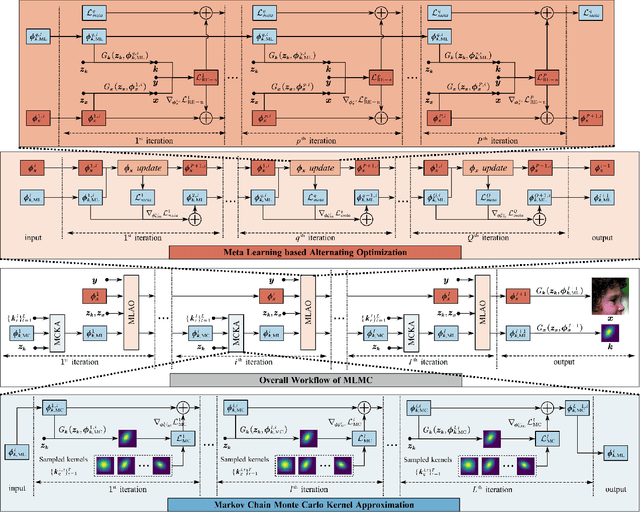
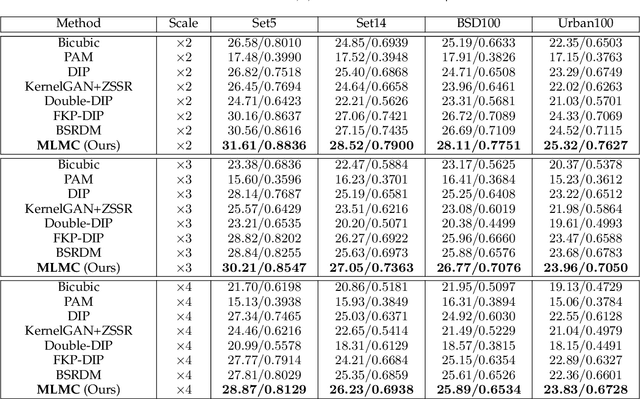
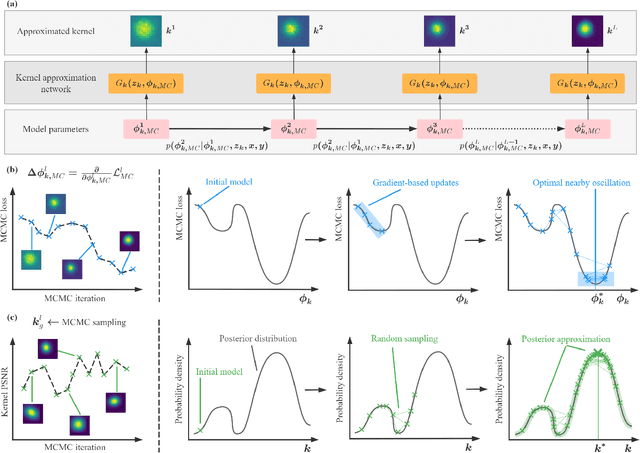

Abstract:Learning-based approaches have witnessed great successes in blind single image super-resolution (SISR) tasks, however, handcrafted kernel priors and learning based kernel priors are typically required. In this paper, we propose a Meta-learning and Markov Chain Monte Carlo (MCMC) based SISR approach to learn kernel priors from organized randomness. In concrete, a lightweight network is adopted as kernel generator, and is optimized via learning from the MCMC simulation on random Gaussian distributions. This procedure provides an approximation for the rational blur kernel, and introduces a network-level Langevin dynamics into SISR optimization processes, which contributes to preventing bad local optimal solutions for kernel estimation. Meanwhile, a meta-learning-based alternating optimization procedure is proposed to optimize the kernel generator and image restorer, respectively. In contrast to the conventional alternating minimization strategy, a meta-learning-based framework is applied to learn an adaptive optimization strategy, which is less-greedy and results in better convergence performance. These two procedures are iteratively processed in a plug-and-play fashion, for the first time, realizing a learning-based but plug-and-play blind SISR solution in unsupervised inference. Extensive simulations demonstrate the superior performance and generalization ability of the proposed approach when comparing with state-of-the-arts on synthesis and real-world datasets. The code is available at https://github.com/XYLGroup/MLMC.
A Dynamic Kernel Prior Model for Unsupervised Blind Image Super-Resolution
Apr 26, 2024



Abstract:Deep learning-based methods have achieved significant successes on solving the blind super-resolution (BSR) problem. However, most of them request supervised pre-training on labelled datasets. This paper proposes an unsupervised kernel estimation model, named dynamic kernel prior (DKP), to realize an unsupervised and pre-training-free learning-based algorithm for solving the BSR problem. DKP can adaptively learn dynamic kernel priors to realize real-time kernel estimation, and thereby enables superior HR image restoration performances. This is achieved by a Markov chain Monte Carlo sampling process on random kernel distributions. The learned kernel prior is then assigned to optimize a blur kernel estimation network, which entails a network-based Langevin dynamic optimization strategy. These two techniques ensure the accuracy of the kernel estimation. DKP can be easily used to replace the kernel estimation models in the existing methods, such as Double-DIP and FKP-DIP, or be added to the off-the-shelf image restoration model, such as diffusion model. In this paper, we incorporate our DKP model with DIP and diffusion model, referring to DIP-DKP and Diff-DKP, for validations. Extensive simulations on Gaussian and motion kernel scenarios demonstrate that the proposed DKP model can significantly improve the kernel estimation with comparable runtime and memory usage, leading to state-of-the-art BSR results. The code is available at https://github.com/XYLGroup/DKP.
A Meta-Learning Based Gradient Descent Algorithm for MU-MIMO Beamforming
Oct 27, 2022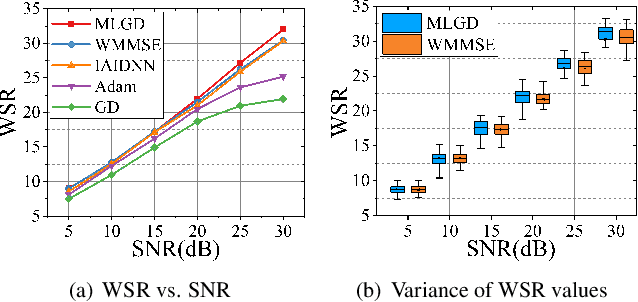

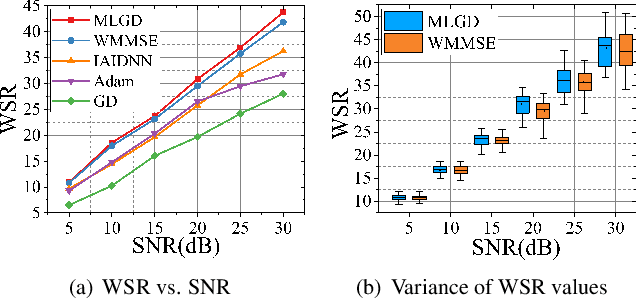
Abstract:Multi-user multiple-input multiple-output (MU-MIMO) beamforming design is typically formulated as a non-convex weighted sum rate (WSR) maximization problem that is known to be NP-hard. This problem is solved either by iterative algorithms, which suffer from slow convergence, or more recently by using deep learning tools, which require time-consuming pre-training process. In this paper, we propose a low-complexity meta-learning based gradient descent algorithm. A meta network with lightweight architecture is applied to learn an adaptive gradient descent update rule to directly optimize the beamformer. This lightweight network is trained during the iterative optimization process, which we refer to as \emph{training while solving}, which removes both the training process and the data-dependency of existing deep learning based solutions.Extensive simulations show that the proposed method achieves superior WSR performance compared to existing learning-based approaches as well as the conventional WMMSE algorithm, while enjoying much lower computational load.
A Learning Aided Gradient Descent for MISO Beamforming
Jun 21, 2022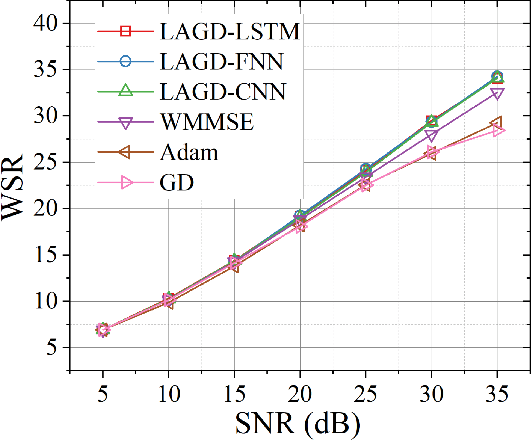


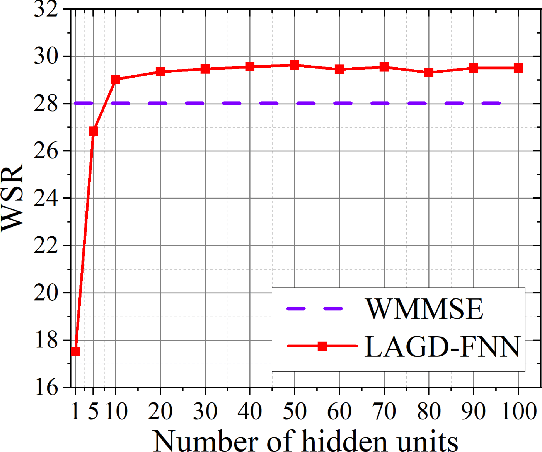
Abstract:This paper proposes a learning aided gradient descent (LAGD) algorithm to solve the weighted sum rate (WSR) maximization problem for multiple-input single-output (MISO) beamforming. The proposed LAGD algorithm directly optimizes the transmit precoder through implicit gradient descent based iterations, at each of which the optimization strategy is determined by a neural network, and thus, is dynamic and adaptive. At each instance of the problem, this network is initialized randomly, and updated throughout the iterative solution process. Therefore, the LAGD algorithm can be implemented at any signal-to-noise ratio (SNR) and for arbitrary antenna/user numbers, does not require labelled data or training prior to deployment. Numerical results show that the LAGD algorithm can outperform of the well-known WMMSE algorithm as well as other learning-based solutions with a modest computational complexity. Our code is available at https://github.com/XiaGroup/LAGD.
DURRNet: Deep Unfolded Single Image Reflection Removal Network
Mar 12, 2022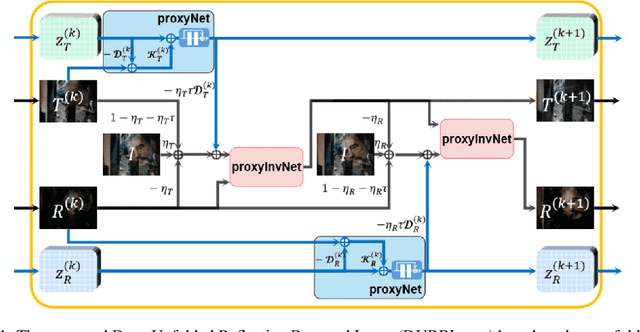

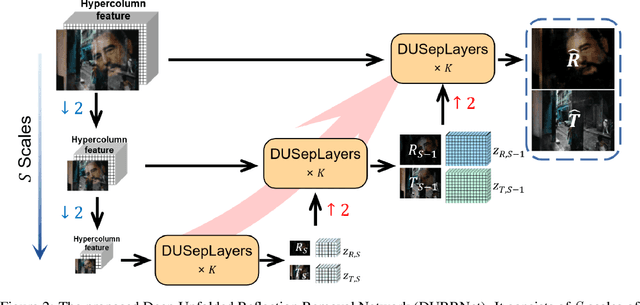

Abstract:Single image reflection removal problem aims to divide a reflection-contaminated image into a transmission image and a reflection image. It is a canonical blind source separation problem and is highly ill-posed. In this paper, we present a novel deep architecture called deep unfolded single image reflection removal network (DURRNet) which makes an attempt to combine the best features from model-based and learning-based paradigms and therefore leads to a more interpretable deep architecture. Specifically, we first propose a model-based optimization with transform-based exclusion prior and then design an iterative algorithm with simple closed-form solutions for solving each sub-problems. With the deep unrolling technique, we build the DURRNet with ProxNets to model natural image priors and ProxInvNets which are constructed with invertible networks to impose the exclusion prior. Comprehensive experimental results on commonly used datasets demonstrate that the proposed DURRNet achieves state-of-the-art results both visually and quantitatively.
GIPA: General Information Propagation Algorithm for Graph Learning
May 13, 2021
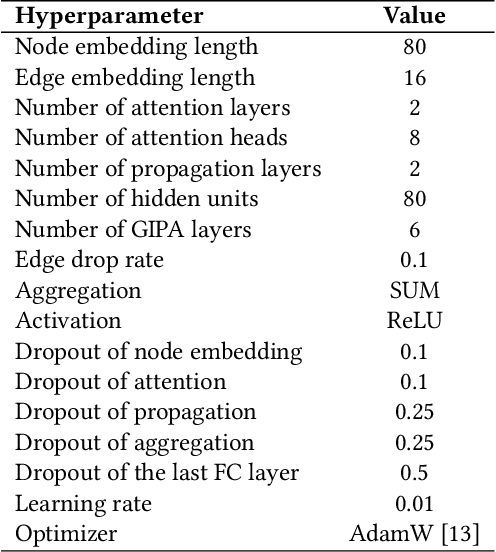
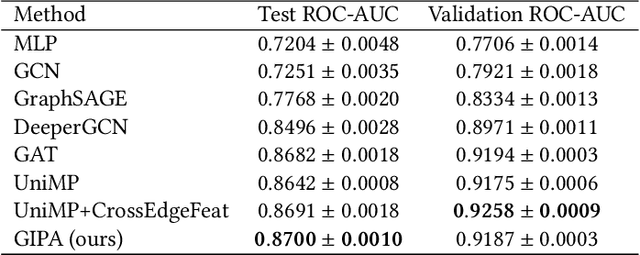
Abstract:Graph neural networks (GNNs) have been popularly used in analyzing graph-structured data, showing promising results in various applications such as node classification, link prediction and network recommendation. In this paper, we present a new graph attention neural network, namely GIPA, for attributed graph data learning. GIPA consists of three key components: attention, feature propagation and aggregation. Specifically, the attention component introduces a new multi-layer perceptron based multi-head to generate better non-linear feature mapping and representation than conventional implementations such as dot-product. The propagation component considers not only node features but also edge features, which differs from existing GNNs that merely consider node features. The aggregation component uses a residual connection to generate the final embedding. We evaluate the performance of GIPA using the Open Graph Benchmark proteins (ogbn-proteins for short) dataset. The experimental results reveal that GIPA can beat the state-of-the-art models in terms of prediction accuracy, e.g., GIPA achieves an average ROC-AUC of $0.8700\pm 0.0010$ and outperforms all the previous methods listed in the ogbn-proteins leaderboard.
Adversary-resilient Inference and Machine Learning: From Distributed to Decentralized
Aug 23, 2019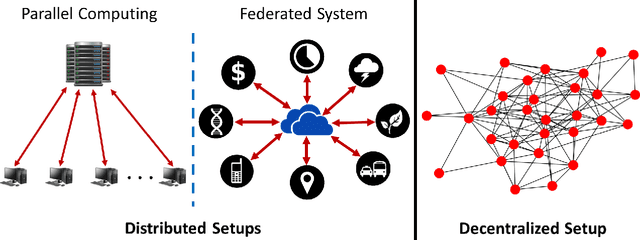


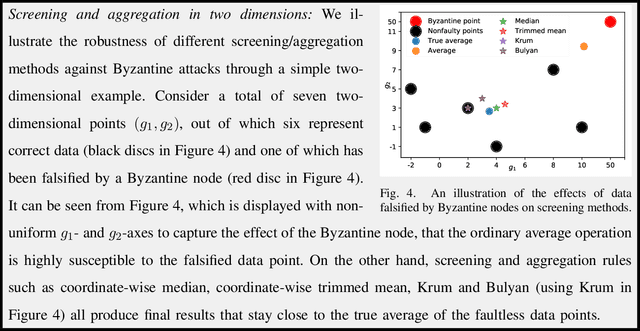
Abstract:While the last few decades have witnessed a huge body of work devoted to inference and learning in distributed and decentralized setups, much of this work assumes a non-adversarial setting in which individual nodes---apart from occasional statistical failures---operate as intended within the algorithmic framework. In recent years, however, cybersecurity threats from malicious non-state actors and rogue nations have forced practitioners and researchers to rethink the robustness of distributed and decentralized algorithms against adversarial attacks. As a result, we now have a plethora of algorithmic approaches that guarantee robustness of distributed and/or decentralized inference and learning under different adversarial threat models. Driven in part by the world's growing appetite for data-driven decision making, however, securing of distributed/decentralized frameworks for inference and learning against adversarial threats remains a rapidly evolving research area. In this article, we provide an overview of some of the most recent developments in this area under the threat model of Byzantine attacks.
BRIDGE: Byzantine-resilient Decentralized Gradient Descent
Aug 21, 2019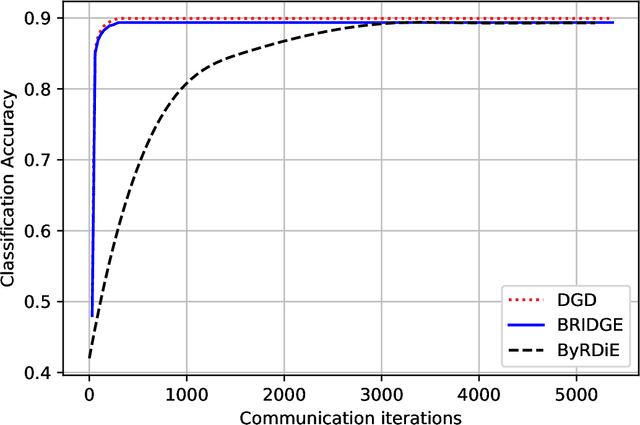
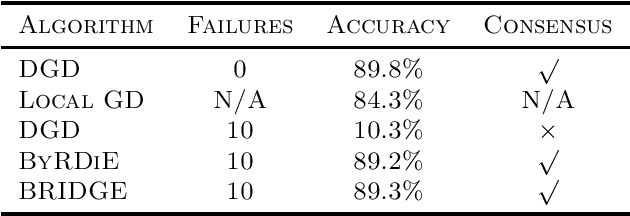

Abstract:Decentralized optimization techniques are increasingly being used to learn machine learning models from data distributed over multiple locations without gathering the data at any one location. Unfortunately, methods that are designed for faultless networks typically fail in the presence of node failures. In particular, Byzantine failures---corresponding to the scenario in which faulty/compromised nodes are allowed to arbitrarily deviate from an agreed-upon protocol---are the hardest to safeguard against in decentralized settings. This paper introduces a Byzantine-resilient decentralized gradient descent (BRIDGE) method for decentralized learning that, when compared to existing works, is more efficient and scalable in higher-dimensional settings and that is deployable in networks having topologies that go beyond the star topology. The main contributions of this work include theoretical analysis of BRIDGE for strongly convex learning objectives and numerical experiments demonstrating the efficacy of BRIDGE for both convex and nonconvex learning tasks.
ByRDiE: Byzantine-resilient distributed coordinate descent for decentralized learning
Sep 25, 2018
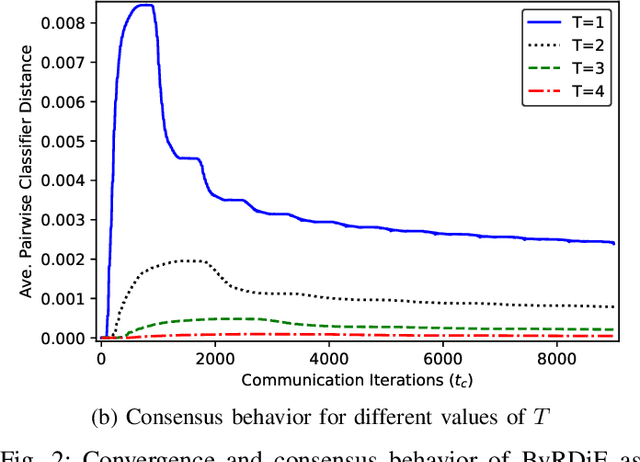
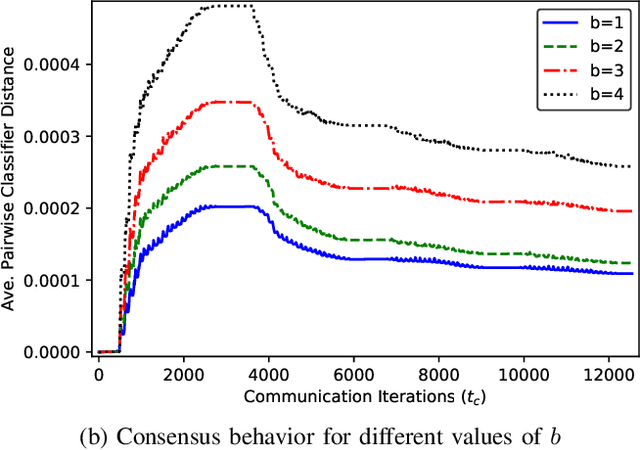

Abstract:Distributed machine learning algorithms enable learning of models from datasets that are distributed over a network without gathering the data at a centralized location. While efficient distributed algorithms have been developed under the assumption of faultless networks, failures that can render these algorithms nonfunctional occur frequently in the real world. This paper focuses on the problem of Byzantine failures, which are the hardest to safeguard against in distributed algorithms. While Byzantine fault tolerance has a rich history, existing work does not translate into efficient and practical algorithms for high-dimensional distributed learning. In this paper, two variants of an algorithm termed \emph{Byzantine-resilient distributed coordinate descent} (ByRDiE) are developed and analyzed that enable distributed learning in the presence of Byzantine failures. Theoretical analysis and numerical experiments presented in the paper highlight the usefulness of ByRDiE for high-dimensional distributed learning in the presence of Byzantine failures.
 Add to Chrome
Add to Chrome Add to Firefox
Add to Firefox Add to Edge
Add to Edge